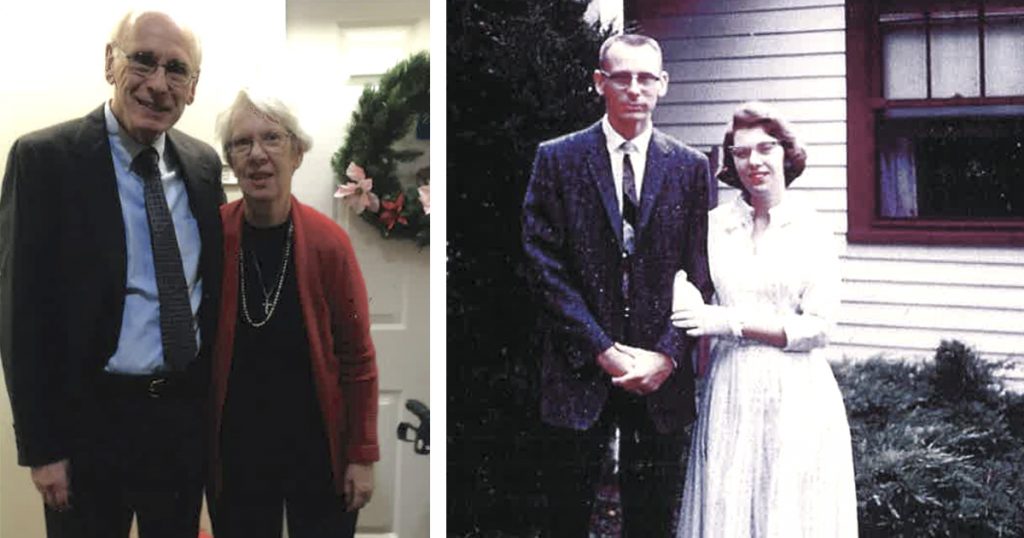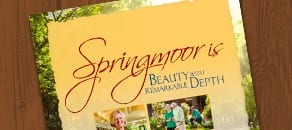
While Larry Larsen and his wife Carole were on the Springmoor waitlist, they received our monthly calendar of community activities in the mail. One item—our Life Writing Workshop, conducted by Dr. Jim Clark (NCSU Professor of English Emeritus)—quickly caught Larry’s eye. He had been writing personal history off and on for nearly 50 years by then and was interested in joining the group.
In December of 2017, about eight weeks after moving in, Larry attended his first workshop meeting. He found that attendees took turns reading their work aloud to the group. As of June 2021, Larry has shared 37 readings with fellow participants. “I’ve been a regular at the monthly meetings,” he says. “We typically have about a dozen people attend.”
Larry traces his involvement with life writing to 1969, when he jotted down a brief description of an event that occurred 10 years earlier; this was followed by a second similar piece in 1972. In 1975, he wrote of a girl from his hometown, Anna, Illinois, who perished in a plane crash. Then, in 1985, after learning the house he most associated with his boyhood had burned down, he scribbled out a long description of that house. He later expanded this piece to include stories of his growing-up years in Anna.
In 1986, after acquiring his first personal computer, Larry transcribed all of his handwritten pieces. He continued saving notes and thoughts on the computer. After retiring from IBM in 1993, he began writing his first extended piece of personal history, one that would incorporate his two earliest handwritten passages. To date, his personal history collection has grown to over 400,000 words. This equates to about 470 pages, plus picture pages he made to illustrate the pieces. He assembled all of this material in three loose-leaf binders.
“Attending workshop meetings gives me ideas for my own writing,” Larry says. “The majority of people who participate in the group are either North Carolina natives or from elsewhere in the South. Their readings often relate to North Carolina history and various North Carolinians. One of the reasons I pick some of the topics I do for my readings is to give people a view of what life is like elsewhere in the country.”
Larry enjoys the informal atmosphere of the group meetings. “It’s all very casual,” he says, “which helps people feel comfortable about sharing their work. Dr. Clark knows a lot about numerous topics—especially North Carolina history—and is often able to ask questions that lead to interesting discussions.”
Why Larry Writes Personal History
In the beginning, Larry says, he wrote stories about his past simply to preserve the memories. As his collection of writing grew, however, he increasingly felt those stories might one day be of interest to his family. Though he says he doesn’t usually have a specific audience in mind when he’s writing a piece, it’s clear that leaving a legacy for family is part of the motivation for his extensive efforts.
The first reading Larry chose to share with the life writing group at Springmoor was the dedication of his personal history collection to his family. He and his wife Carole have three sons and five grandchildren who live in North Carolina. Their 26-year-old granddaughter Holly is also an accomplished writer.
Making the effort to write has significant intellectual and emotional benefits as well. “Writing helps keep you sharp,” Larry says. “It helps me process and make sense of important life events.” He continues, “When you write, you discover your memory is much better than you thought. I usually start with a specific memory of some event, or of a person or a place. The more I write about that topic, the more I remember. I’ve written 14 major pieces that vary in length from 12 pages to 163 pages.”
Larry has approached writing personal history in three different ways: The first of these is to create a written “snapshot” of a single event. He does this as a way to capture the details he wants to remember about specific people or incidents. A second approach he has tried is to use transcribed journal entries to describe what a life experience felt like when it occurred. Doing this conveys a sense of immediacy that is often lacking in retrospective writing. Writing personal history using letters often provides a similar sense of immediacy, Larry finds.
In his piece “Thinking about Why,” Larry carefully examines his motivations for life writing. One version of the piece begins this way: “Just inside the double doors of the Wellness Center in Springmoor’s South Village, a sign mounted high on the wall proclaims, ‘Motivation is what gets you started. Habit is what keeps you going.’ By chance, I was thinking about the Life Writing Workshop the first time I spotted that sign, and I immediately began wondering, as I had many times before, what it was that motivated me to begin writing about my life.”
In this short piece, Larry continues to explore this topic of motivation, and ultimately concludes that although he can’t really pinpoint why he felt compelled to begin, “… it simply felt wrong, once I had started [writing], not to continue doing it.” When asked directly why he writes, Larry says that writing about his life seems to help clarify the meaning of life for him. “Writing helps me get closer to understanding my purpose,” he says.
We All Have a Story to Tell
Born in 1936 in Chester, Illinois, Larry grew up in a little town called Anna, in Southern Illinois. The second piece he shared with the life writing group at Springmoor is about an old stable that was attached to the garage of the house he lived in as a boy. He has many fond memories of playing with friends there.
Exploring his family history is meaningful for him as well. Larry’s mother was from Missouri, and his father was originally from Wisconsin. The third piece he read for the group, one called “Some Past as Prologue,” explains why his family came to live in Anna.
The fourth piece shared with the workshop concerns the department store in Anna that his father managed. Larry worked there as a clerk while in high school. Despite being a painfully shy teen, he sometimes found it interesting, even enlightening, to interact with customers. He writes in detail about a middle-aged woman who confided she had never learned to read and then asked Larry to read aloud a letter she had received from her daughter.
Larry has also written extensively about his relationship with Carole, his wife of 61 years. The two of them met on a triple blind date in 1958 and were married 20 months later.
At the time of their first date, Carole was a nursing student at Presbyterian St. Luke’s Hospital School of Nursing (now Rush University) in Chicago. She was in Anna for training in psychiatric nursing care. Larry was an engineering student at the University of Illinois at Urbana-Champaign but was home for a weekend.
As he and two buddies were driving around on Saturday night, talking about going to a movie, they drove through the hospital campus where Carole was a student. Larry, on a whim, decided to stop at the student nurses’ residence hall and try to persuade three girls to go with them.
“I was uncomfortable with girls and had never had a date,” Larry says. “Yet somehow I talked my way past the house mother and managed to get three dates for the evening. This story is part of the trilogy I wrote about Carole and me: the first part is how we met; the second, our courtship; and the third piece talks about our first six years of married life.”
In the 13 months before they became engaged, Larry and Carole were only able to be together on six occasions. “The rest of the time we wrote lots and lots of letters,” says Larry, describing this as “courtship by mail.”
He continues, “I saved every letter I got from Carole and filed them in a shoebox; Carole likewise saved all my letters to her. My letters to her were instrumental in my being able to write about our courtship and engagement. Occasionally, as I wrote, Carole would remember things I didn’t and correct things I’d gotten wrong.”
After six years with IBM in upstate New York, the company moved the young family to Raleigh. Larry had a number of different roles at IBM, but when he retired he was working at defining architectures for specialized microprocessors called “signal processors.” Larry wrote extensively as an engineer with Big Blue, but it was all technical writing. “I worked at IBM for 33 years, 2 months, and 12 days,” he adds with his customary precision.

Beginning a New Phase of Life at Springmoor
“When I first met Larry, he gave me a business card that featured an image suggestive of Frank Lloyd Wright,” says Beth Holden, Director of Sales and Marketing at Springmoor. “He and Carole have a two-bedroom deluxe floor plan, and he used his computer to figure out how their furniture would fit best.”
Beth adds, “Larry’s career at IBM and life-long interest in architecture contributed to his ability to customize his apartment. This customization seemed to facilitate their transition to retirement living at Springmoor.”
Larry says, “I’ve always been interested in architecture, and at about the time I retired from IBM I began collecting books about Frank Lloyd Wright’s work. That’s where I learned about the art glass he designed for many of his early houses.… I decided to try designing some myself using a dogwood tree as the motif. I used the finished design in several places including as the logo for my business card. It also appears on the title page of each volume of my personal history collection.”
Larry goes on to explain his thought process behind the logo: “It’s a stained-glass window design—a stylized representation of a dogwood tree in late summer.… The horizontal orange band at the bottom of the design is intended to depict the North Carolina red clay from which the tree grows; the central brown shaft is the tree trunk. The green triangles are the leaves, and the small red squares atop the leaves symbolize clusters of ripe dogwood berries. The blue borders and yellow corners are meant to suggest sky and sun.”
Springmoor offers a wide range of enriching activities, and residents choose to participate in those that suit their needs and interests. Intellectual activities in addition to the life writing workshop include book clubs and discussion groups. We offer something for everyone: bridge, movies, art classes, live music, excursions, 40+ exercise land and water exercise classes, individual gardening plots, worship services, volunteer opportunities, and social gatherings of all types (usually with delicious food from our Dining Services Team!). Call 919-848-7080 today to schedule your personalized tour of our beautiful campus.




